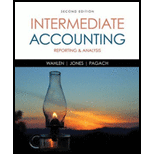
Intermediate Accounting: Reporting and Analysis
2nd Edition
ISBN: 9781285453828
Author: James M. Wahlen, Jefferson P. Jones, Donald Pagach
Publisher: Cengage Learning
expand_more
expand_more
format_list_bulleted
Concept explainers
Question
Chapter 9, Problem 4GI
To determine
State whether the given statement is true or false.
Expert Solution & Answer
Want to see the full answer?
Check out a sample textbook solution
Students have asked these similar questions
Answer? ? Financial accounting question
Compute the standard direct material cost of a wooden cabinet
need this general accounting subjects solutions
Chapter 9 Solutions
Intermediate Accounting: Reporting and Analysis
Ch. 9 - Prob. 1GICh. 9 - Prob. 2GICh. 9 - List the three characteristics of a liability....Ch. 9 - Prob. 4GICh. 9 - Prob. 5GICh. 9 - Prob. 6GICh. 9 - Prob. 7GICh. 9 - Prob. 8GICh. 9 - How does materiality affect the accounting for...Ch. 9 - Distinguish between an interest-bearing note and a...
Ch. 9 - Prob. 11GICh. 9 - How should long-term debt that is callable by a...Ch. 9 - Prob. 13GICh. 9 - Prob. 14GICh. 9 - Prob. 15GICh. 9 - Prob. 16GICh. 9 - Prob. 17GICh. 9 - Prob. 18GICh. 9 - Prob. 19GICh. 9 - Prob. 20GICh. 9 - Prob. 21GICh. 9 - Prob. 22GICh. 9 - Prob. 23GICh. 9 - Prob. 24GICh. 9 - Prob. 25GICh. 9 - Prob. 26GICh. 9 - Prob. 27GICh. 9 - Prob. 28GICh. 9 - Prob. 1MCCh. 9 - Prob. 2MCCh. 9 - When a company receives a deposit from a customer...Ch. 9 - Prob. 4MCCh. 9 - Prob. 5MCCh. 9 - Prob. 6MCCh. 9 - Prob. 7MCCh. 9 - Prob. 8MCCh. 9 - Prob. 9MCCh. 9 - Prob. 10MCCh. 9 - Rescue Sequences LLC purchased inventory by...Ch. 9 - Use the same information in RE9-1 except that the...Ch. 9 - Cee Co.s fiscal year begins April 1. At the...Ch. 9 - Prob. 4RECh. 9 - Prob. 5RECh. 9 - Smith Company is required to charge customers an...Ch. 9 - Wallace Corporation summarizes the following...Ch. 9 - Prob. 8RECh. 9 - Prob. 9RECh. 9 - Prob. 10RECh. 9 - After years of experience, Dilcort Company...Ch. 9 - Prob. 1ECh. 9 - Prob. 2ECh. 9 - Prob. 3ECh. 9 - Prob. 4ECh. 9 - Prob. 5ECh. 9 - Prob. 6ECh. 9 - Prob. 7ECh. 9 - Refundable Deposits Party Warehouse Inc. rents a...Ch. 9 - Prob. 9ECh. 9 - Prob. 10ECh. 9 - Prob. 11ECh. 9 - Prob. 12ECh. 9 - Prob. 13ECh. 9 - Prob. 14ECh. 9 - Prob. 15ECh. 9 - Prob. 16ECh. 9 - Prob. 17ECh. 9 - Prob. 18ECh. 9 - Prob. 19ECh. 9 - Prob. 20ECh. 9 - Prob. 21ECh. 9 - Prob. 22ECh. 9 - Prob. 1PCh. 9 - Prob. 2PCh. 9 - Prob. 3PCh. 9 - Prob. 4PCh. 9 - Prob. 5PCh. 9 - Prob. 6PCh. 9 - Prob. 7PCh. 9 - Prob. 8PCh. 9 - Prob. 9PCh. 9 - Prob. 10PCh. 9 - Prob. 11PCh. 9 - Prob. 12PCh. 9 - Prob. 13PCh. 9 - Prob. 14PCh. 9 - Prob. 15PCh. 9 - Prob. 16PCh. 9 - Prob. 17PCh. 9 - Prob. 18PCh. 9 - Prob. 1CCh. 9 - Prob. 2CCh. 9 - Prob. 3CCh. 9 - Prob. 4CCh. 9 - Various Contingency Issues Skinner Company has the...Ch. 9 - Prob. 6CCh. 9 - Prob. 7CCh. 9 - Prob. 8CCh. 9 - Prob. 10C
Knowledge Booster
Learn more about
Need a deep-dive on the concept behind this application? Look no further. Learn more about this topic, accounting and related others by exploring similar questions and additional content below.Similar questions
- correct answer pleasearrow_forwardThe following data were selected from the records of Fluwars Company for the year ended December 31, current year: Balances at January 1, current year: Accounts receivable (various customers) $ 111,500 Allowance for doubtful accounts 11,200 The company sold merchandise for cash and on open account with credit terms 1/10, n/30, without a right of return. The following transactions occurred during the current year: Sold merchandise for cash, $252,000. Sold merchandise to Abbey Corp; invoice amount, $36,000. Sold merchandise to Brown Company; invoice amount, $47,600. Abbey paid the invoice in (b) within the discount period. Sold merchandise to Cavendish Inc.; invoice amount, $50,000. Collected $113,100 cash from customers for credit sales made during the year, all within the discount periods. Brown paid its account in full within the discount period. Sold merchandise to Decca Corporation; invoice amount, $42,400. Cavendish paid its account in full after the…arrow_forwardcan you please solve thisarrow_forward
arrow_back_ios
SEE MORE QUESTIONS
arrow_forward_ios
Recommended textbooks for you
 Intermediate Accounting: Reporting And AnalysisAccountingISBN:9781337788281Author:James M. Wahlen, Jefferson P. Jones, Donald PagachPublisher:Cengage Learning
Intermediate Accounting: Reporting And AnalysisAccountingISBN:9781337788281Author:James M. Wahlen, Jefferson P. Jones, Donald PagachPublisher:Cengage Learning Cornerstones of Financial AccountingAccountingISBN:9781337690881Author:Jay Rich, Jeff JonesPublisher:Cengage Learning
Cornerstones of Financial AccountingAccountingISBN:9781337690881Author:Jay Rich, Jeff JonesPublisher:Cengage Learning Auditing: A Risk Based-Approach (MindTap Course L...AccountingISBN:9781337619455Author:Karla M Johnstone, Audrey A. Gramling, Larry E. RittenbergPublisher:Cengage Learning
Auditing: A Risk Based-Approach (MindTap Course L...AccountingISBN:9781337619455Author:Karla M Johnstone, Audrey A. Gramling, Larry E. RittenbergPublisher:Cengage Learning

Intermediate Accounting: Reporting And Analysis
Accounting
ISBN:9781337788281
Author:James M. Wahlen, Jefferson P. Jones, Donald Pagach
Publisher:Cengage Learning

Cornerstones of Financial Accounting
Accounting
ISBN:9781337690881
Author:Jay Rich, Jeff Jones
Publisher:Cengage Learning

Auditing: A Risk Based-Approach (MindTap Course L...
Accounting
ISBN:9781337619455
Author:Karla M Johnstone, Audrey A. Gramling, Larry E. Rittenberg
Publisher:Cengage Learning
